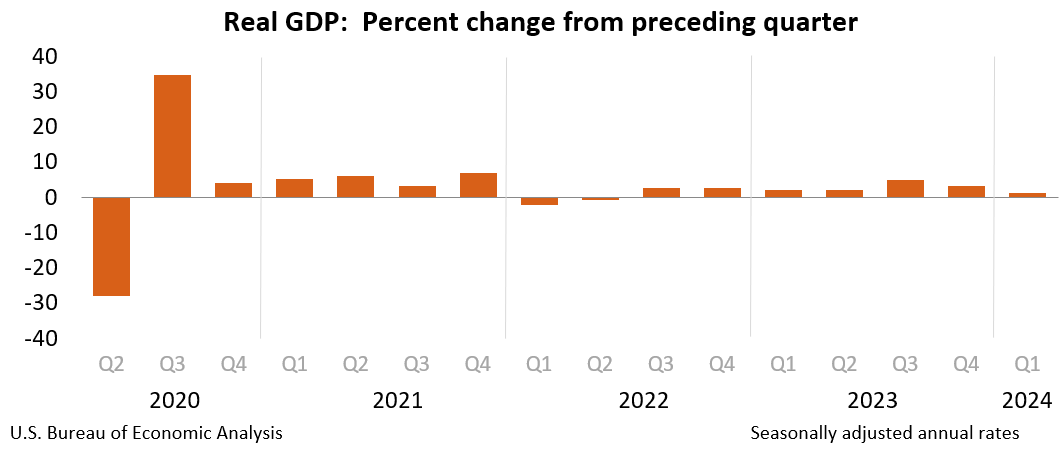Real gross domestic product (GDP) grew at an annual rate of 1.3% in the first quarter of 2024 (Table 1), according to the “second” estimate released by the Bureau of Economic Analysis. In the fourth quarter of 2023, real GDP increased by 3.4 percent.
The GDP estimate released today is based on more comprehensive source data than was available for the “advance” estimate released last month. In the preliminary estimate, the increase in real GDP was 1.6 percent. The update primarily reflects a downward revision to consumer spending (see “GDP Updates”).
The increase of Real GDP primarily reflects increases in consumer spending, residential fixed investment, nonresidential fixed investment, and state and local government spending, which were partly offset by decreases in private inventory investment. Imports, which constitute a subtraction in the calculation of GDP, increased (Table 2).

Compared to the fourth quarter, the deceleration Real GDP in the first quarter primarily reflects a deceleration in consumer spending, exports, and state and local government spending, as well as a slowdown in federal government spending. These movements were partly offset by an acceleration in residential fixed investment. Imports have accelerated.
GDP in current dollars grew 4.3 percent year-on-year, or $298.9 billion, in the first quarter to reach a level of $28.26 billion, a downward revision of $28.6 billion from to the previous estimate (tables 1 and 3). Further information on the source data underlying the estimates is available in the “Key source data and assumptions” file on the BEA website.
THE gross domestic purchases price index rose 3.0 percent in the first quarter, a downward revision of 0.1 percentage points from the previous estimate. THE personal consumption expenditures (PCE) price index increased by 3.3 percent, a downward revision of 0.1 percentage point. Excluding food and energy prices, the PCE price index increased by 3.6 percent, a downward revision of 0.1 percentage point.
Personal income
Personal income in current dollars increased by $404.4 billion in the first quarter, a downward revision of $2.6 billion from the previous estimate. The increase in the first quarter mainly reflects the increase in remuneration (led by private sector wages and salaries) and receipts from personal current transfers (led by public social benefits granted to individuals) (Table 8).
Disposable personal income rose $266.7 billion, or 5.3 percent, in the first quarter, an upward revision of $40.5 billion from the previous estimate. Actual personal disposable income increased by 1.9 percent, an upward revision of 0.8 percentage points.
Personal savings was $796.6 billion in the first quarter, an upward revision of $96.6 billion from the previous estimate. THE personal savings ratePersonal savings as a percentage of personal disposable income was 3.8 percent in the first quarter, an upward revision of 0.2 percentage points.
Gross domestic income and corporate profits
Real gross domestic income (RNB) rose 1.5 percent in the first quarter, compared to a 3.6 percent increase (revised) in the fourth quarter. THE average of real GDP and real RIBa supplemental measure of U.S. economic activity that weights GDP and GNI equally, increased 1.4 percent in the first quarter, compared with a 3.5 percent increase in the fourth quarter (Table 1).
Benefits of current production (corporate profits with adjustments for the value of inventories and capital consumption) decreased by $21.1 billion in the first quarter, compared to an increase of $133.5 billion in the fourth quarter (Table 10).
Profits of domestic financial companies increased by $73.7 billion in the first quarter, compared to an increase of $5.9 billion in the fourth quarter. Profits of domestic non-financial corporations decreased by $114.1 billion, compared to an increase of $136.5 billion. Profits from the rest of the world increased by $19.3 billion, compared to a decrease of $8.9 billion. In the first quarter, receipts increased by $29.8 billion and payments by $10.5 billion.
GDP Updates
With the second estimate, downward revisions to consumer spending, private inventory investment, and federal government spending were partly offset by upward revisions to state and local government spending, fixed investment non-residential, residential fixed investment and exports. Imports were revised upwards. For more information, see the technical note. For more information on GDP updates, see the “Additional Information” section that follows.
| Advance estimate | Second estimate | |
|---|---|---|
| (Percentage change from previous quarter) | ||
| Real GDP | 1.6 | 1.3 |
| GDP in current dollars | 4.8 | 4.3 |
| Real RDB | … | 1.5 |
| Average of real GDP and real GNI | … | 1.4 |
| Gross domestic purchases price index | 3.1 | 3.0 |
| PCE Price Index | 3.4 | 3.3 |
| PCE price index excluding food and energy | 3.7 | 3.6 |
Fourth Quarter Wage and Salary Updates
In addition to presenting updated estimates for the first quarter, today’s release presents revised estimates for fourth quarter wages and salaries, personal taxes and government social insurance contributions, based on the data updates from the Bureau of Labor Statistics’ quarterly employment and wage census. program. Wages and salaries are now estimated to have increased by $58.5 billion in the fourth quarter, a downward revision of $73.0 billion. Current personal income tax is now estimated to have increased by $27.1 billion, a downward revision of $12.6 billion. Government social insurance contributions are now estimated to have increased by $8.3 billion, a downward revision of $9.6 billion. With the incorporation of this new data, real gross domestic income is now expected to have increased by 3.6 percent in the fourth quarter, a downward revision of 1.2 percentage points from the previously published estimate.
* * *
Next release, June 27, 2024, 8:30 a.m. EDT
Gross domestic product (third estimate)
Corporate profits (revised estimate)
Gross domestic product by industry
First quarter 2024
* * *